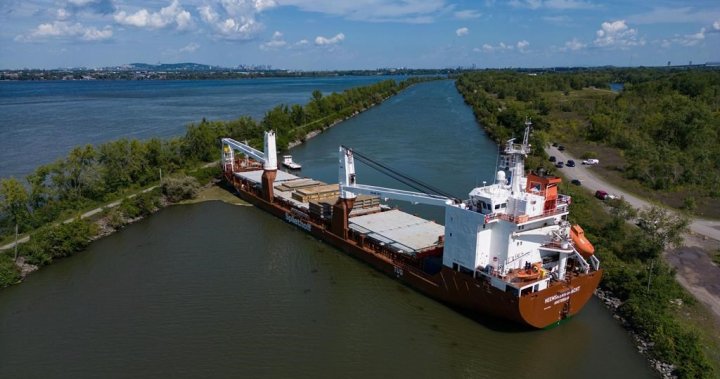A 138-metre cargo ship was recently stuck near Montreal but has now been successfully freed. Fisheries and Oceans Canada reported that two tugboats were able to tow the Dutch ship that had been blocking traffic in the St. Lawrence Seaway. The ship, named Heemskerkgraacht, originally from the Netherlands, had experienced an engine problem which caused it to run aground late Thursday near the Mohawk territory of Kahnawake. This obstruction in the water system led to traffic delays and disruptions in the area.
The Dutch vessel, carrying scrap metal, was on its way to a port city in Spain when it stalled. Officials stated that the ship was attempting to perform a U-turn when it lost power, resulting in an engine blackout. In response, the crew dropped a bow anchor, causing the stern to hit the ground and the ship to become stuck. Despite efforts to free the vessel, it remained stuck until the tugboats were able to successfully tow it away from the grounding site.
As a result of the successful towing operation, ship traffic in the St. Lawrence Seaway is beginning to resume. However, authorities have warned that it could take up to three days for traffic to return to normal in the area. The St. Lawrence Seaway Management Corporation is actively working to manage the situation and ensure a safe and efficient return to regular operations. The incident serves as a reminder of the importance of effective navigation and maintenance in busy waterways like the St. Lawrence Seaway to prevent disruptions and delays.
This incident highlights the complex logistics and challenges involved in managing maritime transportation, especially in busy waterways like the St. Lawrence Seaway. The successful towing of the stuck cargo ship demonstrates the expertise and coordination required to address such emergencies promptly and effectively. It also underscores the potential impact of shipping disruptions on the local economy and communities that rely on the waterway for transportation and trade. Moving forward, authorities will likely review the incident to identify lessons learned and implement measures to prevent similar incidents in the future.
The Heemskerkgraacht incident serves as a cautionary tale for the maritime industry and underscores the importance of proper navigation, maintenance, and emergency response protocols. Shipping companies and crew members must ensure that vessels are adequately maintained and equipped to prevent engine failures and other mechanical issues that could lead to accidents or groundings. Additionally, prompt and coordinated response efforts, such as the successful towing operation in this case, are essential to minimize disruptions and mitigate risks associated with stranded or stuck vessels in busy waterways.
Overall, the successful towing of the Dutch cargo ship near Montreal serves as a reminder of the unpredictable nature of maritime operations and the importance of preparedness and response capabilities in emergency situations. By learning from incidents like this one and implementing proactive measures to prevent similar occurrences, authorities can help ensure the safe and efficient operation of maritime transportation systems. It is essential for all stakeholders in the maritime industry to prioritize safety, efficiency, and sustainability in their operations to minimize risks and uphold the integrity of global shipping networks.


